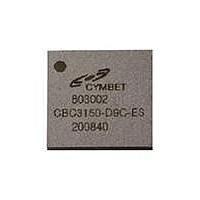CBC3150-D9C-TR1 Cymbet Corporation, CBC3150-D9C-TR1 Datasheet - Page 6

CBC3150-D9C-TR1
Manufacturer Part Number
CBC3150-D9C-TR1
Description
IC BATT SOLID ST ENERCHIP 20DFN
Manufacturer
Cymbet Corporation
Series
EnerChip™ CCr
Specifications of CBC3150-D9C-TR1
Voltage - Output
3.3V
Capacity
50µAh
Operating Temperature
-20°C ~ 70°C
Package / Case
20-DFN
Battery Cell Size
9 mm x 9 mm
Output Voltage
3.3 V
Termination Style
SMD/SMT
Lead Free Status / RoHS Status
Lead free / RoHS Compliant
For Use With
859-1003 - INDUCTIVE CHARGING EVAL KIT859-1001 - ENERCHIP CC EVAL KIT
Lead Free Status / Rohs Status
Lead free / RoHS Compliant
Other names
859-1008-2
CBC3150-D9C-TR1
CBC3150-D9C-TR1
Available stocks
Company
Part Number
Manufacturer
Quantity
Price
Company:
Part Number:
CBC3150-D9C-TR1
Manufacturer:
XILINX
Quantity:
335
Pulse Discharge Current for a Wireless End Device
Pulse discharge currents place special demands on energy storage devices. Repeated delivery of pulse
currents exceeding the recommended load current of a given chemistry will diminish the useful life of the cell.
The effects can be severe, depending on the amplitude of the current and the particular cell chemistry and
construction. Pulse currents of tens of milliamperes are common in wireless sensor systems during transmit
and receive modes. Moreover, the internal impedance of the cell often results in an internal voltage drop that
precludes the cell from delivering the pulse current at the voltage necessary to operate the external circuit. One
method of mitigating such effects is to place a low Equivalent Series Resistance (ESR) capacitor across the
EnerChip storage device. The EnerChip storage device charges the capacitor between discharge pulses and the
capacitor delivers the pulse current to the load. Specifying the capacitance for a given EnerChip device in an
application is a straightforward procedure, once a few key parameters are known. The key parameters are:
Two equations will be used to calculate two unknown parameters:
Both formulae will assume that the capacitor ESR is sufficiently low to result in negligible internal voltage drop
while delivering the specified pulse current; consequently, only the EnerChip storage device resistance will
be considered in the formula used to compute capacitor charging time and only the load resistance will be
considered when computing the capacitance needed to deliver the discharge current.
The first step in creating an EnerChip storage device-capacitor couple for pulse current applications is to size
the capacitance using the following formula:
Discharge formula: C = t / [ R * ln (Vmax / Vmin) ]
where:
C = output capacitance, in parallel with the EnerChip storage device;
t = pulse duration;
R = load resistance = Vout(average) / Ipulse
Vmin and Vmax are determined by the combination of the EnerChip storage device voltage at a given state-of-
charge and the operating voltage requirement of the external circuit.
Once the capacitance has been determined, the capacitor charging time can be calculated using the following
formula:
Charge formula: t = - R * C * ln [ (Vmax - Vchg) / (Vmin - Vchg) ]
where:
t = capacitor charging time, from Vmin to Vmax
R = EnerChip storage device resistance
C = output capacitance, in parallel with the EnerChip storage device
DS-72-14 Rev A
»
»
»
»
»
»
1) the output capacitance needed to deliver the specified pulse current of a known duration;
2) the latency time that must be imposed between pulses to allow the capacitor to be recharged by the
EnerChip storage device.
EnerChip storage device impedance (at temperature and state-of-charge)
EnerChip storage device voltage (as a function of state-of-charge)
Operating temperature
Pulse current amplitude
Pulse current duration
Allowable voltage droop during pulse discharge
©2010 Cymbet Corporation • Tel: +1-763-633-1780 • www.cymbet.com
EnerChip™ CC Inductive Charging Evaluation Kit
Page 6 of 8
















